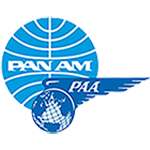OCTOBER 1934
"Clipper #7 Revealed!"

Photo: Pan Am Clipper #7, a Martin M-130, being built at Middle River, MD: Pan American Air Ways, September-October 1934 (PAHF Collection).
The headline said it all; "Flying Clipper Ship Number 7, The World's Mightiest Airliner to Conquer the Oceans is Appearing at Baltimore."
The September-October 1934 Pan American Air Ways issue provided a lavish spread to herald the news that Clipper #7 was about to emerge at the Glenn L. Martin factory in Baltimore. The brand new Martin M-130, later famously known as the “Hawaii Clipper," was the first of three pioneering flying boats developed by Martin for Pan Am. These aircraft would be instrumental in establishing long-distance international air travel. The M-130 could carry up to 46 passengers and featured innovative design elements like fuselage-mounted sponsons. It was the first aircraft to feature Pratt & Whitney Twin-Wasp engines.
As described in Pan American Air Ways, the new aircraft was indeed a big step in the evolution of commercial aviation:
In the great aircraft plant of the Glenn L. Martin Company is rapidly emerging the largest and most advanced aerial transport that the world has ever known, designed to master the great oceans which for 400 years have been unconquerable barriers between the hemispheres.
Into the making of this giant Pan American Clipper Ship have gone years of research in physical and chemical laboratories, of endless hours of tedious engineering designs, of slow and careful toil within the shops.
Pan Am's publicists had every reason to use hyperbole in describing the giant aircraft. After many months of work under wraps following their successful bid to Pan Am to build an advanced new flying boat, the new Martin plane looked very impressive.
The M-130 could carry a useful load of over 22,000 lbs., almost equal to its own weight. It had a range of 3,000 miles. The new Clipper was faster and larger than the Sikorsky S-42, also recently introduced, and would fit the bill for Pan Am's need for a truly transpacific aircraft, even better than the S-42.
Although Clipper #7 was the first M-130 built, it would remain at the factory while the Martin Company tweaked the design. The first M-130 delivered to Pan Am would be NC-14716, the famous "China Clipper." The second M-130 delivered was the "Philippine Clipper," NC-14715. Clipper #7 would bear registration NC-14714. Pan Am had begun numbering four-engined flying boats with the Clipper name with the first Sikorsky S-40, "American Clipper" in 1931, and sequentially numbering subsequent Clippers prior to their official christening by the airline. Thus the first M-130, following on after three S-40s, and the first three S-42s, was "Clipper #7."
In November 1934, during testing, Clipper #7 took off on Chesapeake Bay in an amazing 11 minutes. Far into the future, every Pan Am aircraft would be known as a Clipper. It was a proud heritage.
Althea "Gerry" Lister notes (November 1934).
Robert Gandt, "China Clipper" (Naval Institute Press), 1991.
“Pan American Air Ways,” Vol. 5, No. 6, September-October 1934 (PAHF collection).

